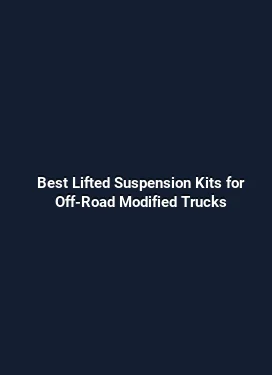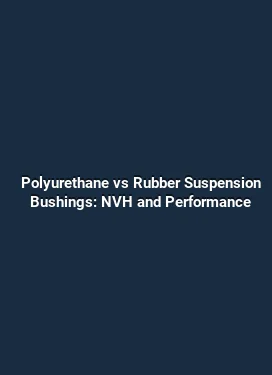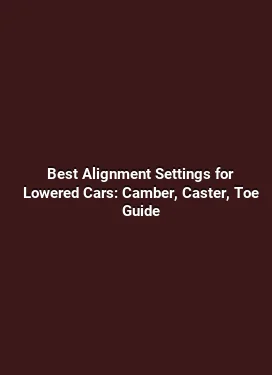How to Install Adjustable Rear Camber Arms on Nissan 350Z
Why Install Adjustable Rear Camber Arms on the Nissan 350Z

The Nissan 350Z, renowned for its balanced chassis, benefits significantly from camber adjustability when pursuing sharper handling and even tire wear. Rear camber arms with adjustable pivots let you fine-tune the wheel’s camber angle, which directly influences tire contact patch during cornering and braking. In high-load cornering, negative camber helps maintain a larger footprint on the outer tire, improving grip and predictability. A properly configured setup can reduce understeer, improve steering response, and promote more uniform tire wear across the tread profile.
When choosing a system, look for robust mounting hardware, reputable bushing materials, and precise adjustment mechanisms. A well-designed rear camber arm kit integrates with the stock suspension geometry without compromising travel, rubbing clearance, or shock absorber clearance. It also should be compatible with common alignment specifications for the Z33 platform family, including the later 350Z variants in both coupe and roadster configurations.
Initial Assessment and Safety Considerations

Before starting, assess the vehicle’s current alignment and suspension condition. Worn bushings, damaged control arms, or excessive rust can affect installation quality and alignment outcomes. Ensure you have a clear workspace with adequate lighting, a jack and stands capable of supporting the vehicle safely, a torque wrench, and the appropriate hand tools. Safety first: block the wheels, disconnect the battery if you’ll be near electrical components, and never work under a vehicle supported only by a jack.
Gather the following baseline information: stock rear camber angle, toe setting, ride height, and any signs of tire feathering or unusual wear. Documenting the baseline helps you compare post-installation results and ensure that the final alignment aligns with your driving goals, whether street comfort, track days, or aggressive street driving.
Selecting the Right Adjustable Rear Camber Arm Kit
There are several considerations when choosing a kit for the 350Z. Compatibility with the rear suspension layout—whether the car uses independent rear suspension with trailing arms or a multi-link arrangement—affects fitment and performance. Material quality is key: forged or billet aluminum arms with rigid, strategic mount points resist flex under load. The bushings should offer a balance between compliance and precision, often a urethane or polyurethane material that reduces deflection without transmitting excessive road chatter.
Adjustment range matters as well. A broader adjustment range allows more precise tuning for different tire compounds, ride heights, and alignment targets. Easy, repeatable adjustment mechanisms—such as threaded rod ends or indexed cam bolts—make it practical to dial in camber settings after changes in ride height or tire setup. Finally, verify that the kit provides full hardware, anti-seize recommendations, and clear instructions that respect the car’s OEM mounting points to minimize the risk of fitment issues.
Understanding Camber, Toe, and Roll Center Impacts
Camber angle is the tilt of the wheel relative to vertical when viewed from the front. Negative camber increases contact patch at the outer tire edge during cornering, but excessive camber can reduce stability at square-on braking or straight-line acceleration. The rear camber setting, in particular, can influence yaw stability and rear-steer feel under throttle. In conjunction with toe, which affects how wheels point in or out, camber adjustments must be coordinated to preserve predictable steering and balanced grip levels.
Roll center dynamics and suspension geometry also play a role. Aftermarket arms should maintain or improve roll center behavior to prevent excessive squat or dive under braking. A well-tuned rear camber arm kit works with existing rear bushings and links to preserve predictable load paths, reducing unpredictable changes in tire contact during transitions between braking, acceleration, and cornering forces.
Step-by-Step Installation Process
Note: Always refer to the specific kit’s installation guide for torque specs and any inline steps unique to the product. The following outline provides a comprehensive workflow that aligns with common rear camber arm installation practices for the 350Z platform.
1. Preparation and Vehicle Setup
Park the car on a flat, level surface. Engage the parking brake and place wheel chocks at the front wheels. Lift the rear of the vehicle and secure with stands on solid points. Remove the rear wheels to access the control arms and mounting brackets. If you are lowering the car or adjusting ride height, do so prior to removal to avoid binding the suspension during work. Inspect the stock arms, bushings, and mounting hardware for wear or damage, and replace anything questionable.
Clean the mounting surfaces and inspect for corrosion. Having a clean mating surface helps ensure proper torque retention and reduces the risk of misalignment when reinstalling the new arms.
2. Removing the Stock Rear Camber Arms
Carefully disconnect the rear lower control arm or trailing arm connections as applicable. Depending on the model year, you may need to loosen or remove adjacent links to gain clear access to the camber arms. Support the arm to avoid sudden movement, then unbolt the mounting points using the correct sockets and wrenches. Compare the stock arm’s length and bolt hole spacing to the new adjustable arm’s hardware to anticipate any alignment implications and to prepare the correct spacers or shims if needed.
Take note of any integrated bushings that may be replaced with the new kit if specified. Some kits replace the stock bushings with higher-midelity units; if so, press or extract them per the kit’s guidelines, paying attention to the sleeve orientation and bushing orientation as required.
3. Installing the Adjustable Rear Camber Arms
Position the new camber arms in place, aligning with the factory mounting points. Hand-tighten the bolts to hold the arm while you verify alignment geometry. If the kit uses adjustable rod ends or cam-plate style adjusters, set the initial camber to a conservative baseline, such as -1.5 to -2.0 degrees, and keep toe close to factory spec to avoid excessive tire wear during the initial test drive.
Torque each mounting bolt to the manufacturer’s recommended specifications. In many cases, rear camber arms use higher-torque appendages at the chassis end, so verify the correct torque for the mounting points and the threaded adjustment portions. If the kit includes a locking mechanism or thread-lock compound, apply as directed to maintain setting under suspension loads.
4. Achieving the Desired Camber and Re-assembly
With the arms in place, cycle the suspension by hand to ensure there is no interference with other components such as brake lines, exhaust, or chassis braces. Rotate the adjustment mechanism to dial in the target camber. If you are new to alignment principles, small iterative changes—quarter-turn adjustments—often yield the most consistent results without overloading the mount points.
Reinstall the wheel and lower the vehicle to the ground. Spin the wheel to confirm free rotation without contact with the arm or bracket. Check for rub spots or binding as you roll the car back and forth to settle the suspension before undertaking alignment checks.
Alignment and Fine-Tuning After Installation
After installing adjustable rear camber arms, a professional or advanced DIY alignment is essential to realize the full benefits. The alignment process targets straight ahead of the toe settings and camber values suitable for your driving goals and tire choice. In street applications, a slight negative camber with toe near zero offers balanced wear and predictable handling. Track-oriented setups may employ more negative camber and a small toe-out to encourage responsive turn-in without sacrificing tire life excessively.
During alignment, verify that the rear wheel camber remains consistent under dynamic load. Pneumatic or laser alignment equipment can measure camber, toe, and caster angles with high precision. If your alignment shop offers corner-weight measurements, consider distributing weight evenly on all four corners to obtain more accurate alignment data. A balanced alignment improves steering feedback, cornering grip, and tire wear patterns, especially when running wider tires or different tire compounds than the stock configuration.
Maintenance Tips for Long-Term Performance
After installation, inspect the rear camber arms at regular intervals—especially after track days or aggressive driving. Check for play in the adjuster mechanism as the threads can accumulate dirt or loosen with vibration. Lubricate moving joints as recommended by the kit manufacturer and replace any worn bushings promptly to prevent misalignment from creaking or loose components.
Maintain awareness of tire wear patterns. If you notice outer-edge wear increasing rapidly or changes in grip feel, recheck camber and toe values. Alignments can shift slightly with load distribution, ride height changes, and suspension travel; periodic checks help preserve handling characteristics and tire longevity.
Real-World Driving Benefits and Practical Scenarios
Installing adjustable rear camber arms translates into tangible grip improvements and more predictable behavior on both street and track surfaces. In daily driving, a modest negative camber can enhance cornering stability and reduce understeer. On canyon roads or winding mountain passes, precise camber tuning helps the rear tires maintain a strong contact patch during aggressive turns, delivering sharper turn-in and improved mid-corner stability.
When switching to harder compounds or wider tires, the camber angle can be revisited to preserve contact with the road surface. This adjustability is particularly valuable when swapping wheel sizes or altering suspension geometry through height changes. By maintaining a controlled contact patch through the tire's life, you can achieve more consistent lap times, steadier dynamic responses, and better braking stability under high-speed cornering.
Common Pitfalls and How to Avoid Them
One common pitfall is excessive camber that leads to reduced straight-line stability or unusual wear patterns on the inner and outer tread edges during daily driving. Start with conservative camber values and validate with a thorough alignment to avoid chasing instability. Another risk is binding or interference with brake calipers or sway bars; always verify clearances after installation and during suspension articulation to ensure no contact occurs when the suspension travels through full range of motion.
Finally, ensure compatibility between the camber arms and other suspension upgrades. If you’ve added sway bars, upgraded shocks, or altered ride height, recheck alignment after a period of driving to account for any cambers or toe changes introduced by the new configuration. This practice helps avoid premature tire wear and ensures consistent handling characteristics across a range of driving scenarios.
Conclusion Through Practical Reflection
Installing adjustable rear camber arms on the Nissan 350Z is a strategic upgrade for drivers seeking refined handling, enhanced cornering grip, and balanced tire wear. The process emphasizes careful preparation, precision installation, and thoughtful alignment to unlock the full potential of the suspension system. By understanding the interplay between camber, toe, and overall chassis dynamics, drivers can tailor their vehicle behavior to match their driving style and road conditions, achieving a more controlled and confident ride across a spectrum of conditions.






